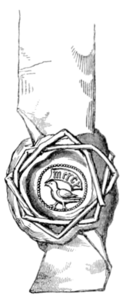Impression sent by Miss Julia K. Bockett, of Reading.
7. Personal Seal, with an heraldic device. It is circular; diameter, nearly 1 inch. The centre is occupied by an escutcheon, a fess, with a demi-lion in chief—✠ SECRETVM . MEVM . MICHI . Date, fourteenth century. The matrix is in the possession of the Rev. James Lee Warner, and was found near Walsingham, in 1847. The arms may be those of Esme, or Esmey.
8. Seal of John Bysshe. Circular seal; diameter, 1112 inch; in the centre an escutcheon of the arms of Bysshe,—a chevron between three cinqfoils (or roses); a single-headed eagle displayed seems to support the shield, and on each side of it is an initial, J. and B.—Sigillum iohannis bysshe armig'. Matrix formerly in the possession of the late Mr. Douce. Date, early in the fifteenth century. Edward Bysshe, in his Notes on Upton, p. 53, remarks that the elder branch of the De la Bisse family, descended from Baldwin de Clare, bore the arms of Clare, 3 chevronels, differenced by a label of five points. But, about t. Rich. II., on account of an alliance with the Staffords, the arms, borne by himself, were adopted, a chevron between 3 roses, as seen on the seal of Sir Thomas Bysshe, 5 Rich. II. It appears from Manning and Bray's Hist. of Surrey, vol. ii., p. 286, that there was a John de Byshe living t. Edward III., also another John, t. Hen. VI., whose son bore the same name.
9. Seal of Hugh of Bourdeaux. Fourteenth century. A small circular seal; diameter, 34 inch. The matrix was found at Winchester, in 1849, in the following singular position. The bark of an old tree having accidentally been struck off by a blow, the seal was discovered underneath the bark. The device is the Holy Lamb. The cross surmounting the banner- staff forms likewise the initial of the legend—S' HVGONIS DE BVRDEVS. Communicated by Mr. Hawkins.
10. Personal Seal, with device and motto, of the time of Henry VI. This interesting Signet, of which by the kindness of Dr. Kidd, Regius Professor of Medicine at Oxford, a representation is given, is one of three small seals appended to a letter of attorney, dated 1433, amongst the curious documents preserved in the charter-chest of Ewelme Hospital, of which the Regius Professor is ex officio the Master. The seal is probably the impress of a ring; it is of red wax. The device is apparently a dove, holding in her mouth a scroll inscribed—mercy. The rush twisted around the impression to preserve it from being defaced, and seemingly in the form of two interlaced squares, is a peculiarity of interest.[1] The three impressions are made upon separate slips, cut horizontally at the lower margin of the little deed, of which they form part, in lieu of the more customary dependent labels of a separate slip, passed through a slit in the parchment. The uppermost seal of the three bears as a device the stock of a tree, with two boughs; the second, a pelican in piety. The lowest slip bears the little impress here shown. It may be the seal of Andrew Sperlynge, the third named in the instrument. The bird may be a sparrow, with an allusion to his name.
- ↑ Compare the fashion of squares interlaced, as on Mr. Hamper's curious seal, Gent. Mag., No. xcv., Pt. ii., pl. 11.

